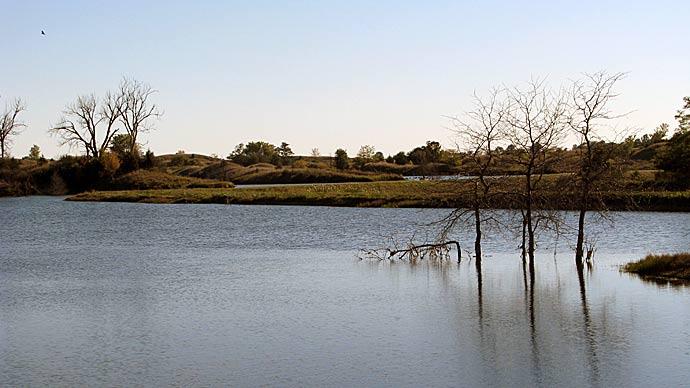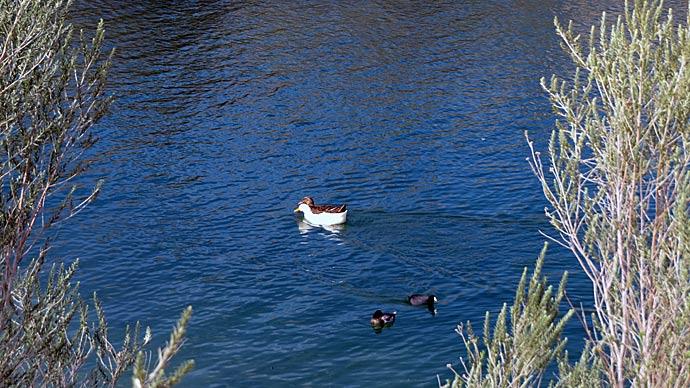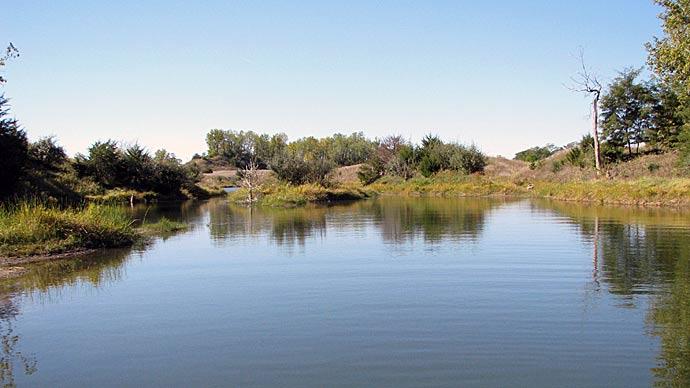When a pond is built, it immediately begins to age. With first rains, water picks up particles of dirt and deposits them into your pond. Over time, lots of rains moves lots of dirt. Throw in the mix of organic matter such as leaves and grass clippings and willow tree limbs, and the life of a pond is limited.
Deep ponds become shallow, yielding to aquatic plants. Ponds evolve to marshes, and marshes to dry land. It could take fifty, maybe a hundred years of collecting the spoils of moving water, but it will happen.
Dirt pushers call this gooey, moving stuff "silt."
Just for kicks, I looked up the word "silt" in a Merriam-Webster Collegiate Dictionary, borrowed from my college-age daughter. It says, "loose sedimentary material with rock particles usually l/20th millimeter or less in diameter."
I've seen lots of silt. Dry, it looks and feels like small grain cornmeal. Wet, it's a sloppy mess akin to mucky black pudding.
If you intend to clean out a pond, and remove silt, the time draws near. Naturally, bulldozer operators like to move dry dirt, not wet, oozing messes.
There's other ways, too.
First job though is to determine your method of attack. The best advice for deepening a pond is to go up, not down. If the dam can be safely raised, or the spillway elevated, look at those options in the beginning. It's much cheaper to raise a dam or bring the grade of a spillway up than it will ever be to dig muck out of a pond bottom.
If depth is your biggest issue, raising the dam could be your best idea.
But, if removing silt is the issue, or the dam can't go up, your choice is to remove bottom sediments. Expect bottom dirt to be moved at least twice...maybe three times. First, it has to be removed from the pond, then spread or hauled away. If hauled away, it then needs to be spread. Each time the dirt is moved, there's a financial cost.
To make your decision, figure out how much silt or bottom sediments you have. Measure the surface area, multiplied by average depth, in feet. Length times width, times depth. Then, divide that number by 27, and you will have cubic yards. Earthmovers think "cubic yards."
Next, see how wet your dirt is. If dirt is dry and hard, a bulldozer can move it. Silt typically has deep, wide cracks when dry. Push a metal pipe, or a piece of steel rebar downward. If you push hard a short distance, then it's easy to push, expect a crust of dry silt on top of a bed of wet stuff. If that's the case, an excavator may be the proper tool for the job.
If you want to remove silt from a lake with water, a small dredge may be the ticket. If the watery area is small, an excavator or "trackhoe" can be used. Other earthmovers use a device called a "mudbucket", pulled by a cable, or attached between two bulldozers which can stay on dry land and tug the bucket through the soupy, sloshy mess of mud.
We just finished a small project, renovating a pond. Due to drought conditions, this two acre pond dropped more than 8 feet. There was a tenth acre puddle in the middle, and the land owner wanted to excavate the silt. This pond is surrounding by a beautiful setting of an oak mott, and can be seen from the picture window of the owner's country cabin. Raising the dam would flood the oaks, so his best choice to deepen the pond was to excavate. The silt ranged in depth to six feet deep. But, the deepest silt sits in water eight feet deep. So, we decided to leave the deepest part alone, and focus on the circle surrounding the shoreline.
Use a D-6 bulldozer, enclosed cab, surround sound music system, we went to work. In order to push slightly wet silt, we have to find the dry dirt beneath. Believe it or not, somewhere underneath that wet, gooey dirt sits dry dirt, usually clay. Remember what the pond bottom looked like when it was built? It still has that same appearance, under those deposited sediments. Starting along the edges, we made cuts with the dozer blade, pushing and rolling silt with solid soils from underneath. As we rolled these soils together, they mixed and broke into smaller chunks. In this case, we pushed everything toward the dam. Once there, we pushed the spoils up and over the top, to the backside of the dam. Remember how silt got there in the first place? If we push and spread it below the dam, it can't wash back into the pond.
Use an excavator when soils are too wet for a bulldozer. One job, several years ago was a doozy. We pumped that pond dry five times. Just as silt was becoming dry enough to dig, it would rain. Big watershed, pond filled. Finally, the owner gave us a deadline to get the job done. So, we could pump the water down with a huge pto driven pump. But, then we had to use an excavator. So, picture a giant bucket at the end of a long bendable arm, on top of a bladeless bulldozer, on tracks. Like a huge Tonka toy, we scooped dirt with the bucket, picked it up, swung around and dumped the silt into a waiting dump truck. The truck hauled the wet mess to another spot on the man's land, dumped it, and we let it dry. Later, we smoothed everything with a bulldozer. Expensive.
Lake Kiowa, a community surrounding a 570 acre lake north of Dallas/Fort Worth, near the Red River, made a decision several years ago to buy their own dredge, and use community employees to deepen areas in shallow coves. It seemed like a wise decision, but operating a dredge is like other pieces of heavy equipment. Just because you know what a lever or pedal does, doesn't mean you can move dirt where you want it. The powers at Lake Kiowa are scratching their heads trying to figure out the best way to use their dredge.
While the pond is down, double-check slopes of your dam. Now is the time to change eroded areas with riprap, or to grade bad slopes. Add fish structure, once construction issues are settled. Want a crossing upstream in boggy soils? Do it now. If pipes are an issue, resolve it now. Got cattails around the edges? Dig them out now. Backside of your emergency spillway eroded? Fix it.
One big issue about cleaning out bottom silt and sediment is what to do with all that dirt. Once you calculate the volume of dirt, make plans where to put it. If you plan to spread it out, around your pond, remember what you are dealing with. Silt moves. Unless you thoroughly mix it with other soils, expect the stuff to head back for your pond.
A client southeast of Dallas bought back the family farm which has a lake on it. He remembers 40 years ago as a kid, fishing in this pristine setting, a pond carved on land originally owned by his great-grandfather. Twenty-something years ago, heirs sold the land. The property sat fallow, growing up with underbrush, and the lake was unkempt.
When the man and his family bought the land, his vision has been to restore the lake and surrounding land to its former beauty. The problem? His lake has lost more than half its depth over the last 60 years of existence. He can't raise the dam, because it would flood a county road. He has no choice but to deepen shallow areas. With a huge volume of dirt to move, he has limits where to put it. So, he chose to give up some of the surface area of the lake by building peninsulas and islands with sediments, mixed with two thirds solid soils from underneath. The result will be a five acre lake deeper than the original lake, but with two islands and three peninsulas. There won't be a spot around his lake that can't be fished from the shore.
He designed it that way.
If you are thinking about deepening your pond here's the rules. First, answer the question, "Can you go up?" If no, then calculate the volume of dirt to be removed from the pond bottom. Then, decide where you will put the material. Those decisions, plus how dry the dirt is, will help you decide what type of equipment is needed. Shop for contractors, and get cost estimates. Book your contractor early, as much as six months in advance.
Picture in your mind what you want the finished product to look like. Be sure to convey that vision to your contractor.
Oversee the project.
After it's all said and done, you want to enjoy the serenity of a revitalized pond.
Reprinted with permission from Pond Boss Magazine



